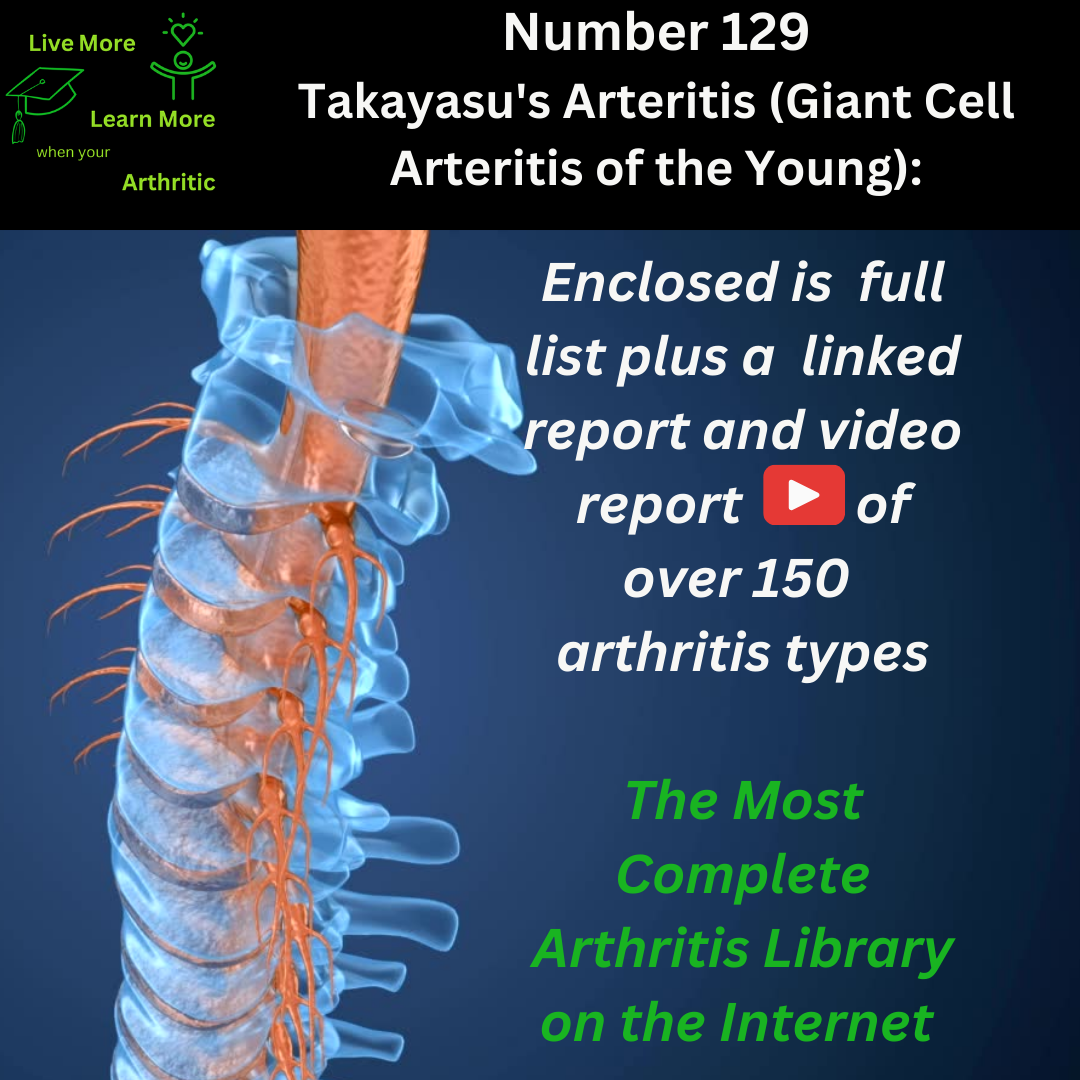
Takayasu’s Arteritis (Giant Cell Arteritis of the Young): Number 129 of around 150 types of Arthritis
Understanding Takayasu’s Arteritis (Giant Cell Arteritis of the Young)Description of the Disease
Takayasu’s arteritis is a rare type of vasculitis that primarily affects the large blood vessels, particularly the aorta and its branches. This chronic inflammatory condition leads to thickening, narrowing, and inflammation of the arterial walls, which can impede blood flow to organs and tissues.
 Parts of the Body Most Affected
Parts of the Body Most Affected
Takayasu’s arteritis predominantly affects large arteries, including the aorta and its major branches such as the carotid arteries, subclavian arteries, and renal arteries. The narrowing and inflammation of these arteries can lead to reduced blood supply to various organs, including the heart, brain, kidneys, and arms.
Symptoms and Limited Range of Motion
Common symptoms of Takayasu’s arteritis include:
- Fatigue
- Muscle and joint pain
- Decreased or absent pulses in the arms or legs
- Dizziness or headaches
- Vision changes or blindness
The limited range of motion can occur due to joint pain and stiffness caused by reduced blood flow and inflammation.
Causes and Triggers
The exact cause of Takayasu’s arteritis is unknown, but it is believed to involve an abnormal immune response targeting blood vessel walls. Genetic factors and environmental triggers, such as infections, may contribute to disease development.
Common Ages of Onset and Risk Factors
Takayasu’s arteritis typically affects young adults under the age of 40, although it can occur at any age. It predominantly affects women, with a female-to-male ratio of approximately 8:1. Genetic predisposition and certain ethnic backgrounds, such as Asian descent, may increase the risk of developing the condition.
Is Takayasu’s Arteritis Autoimmune?
Takayasu’s arteritis is considered an autoimmune disease, where the body’s immune system mistakenly attacks healthy tissues, specifically targeting blood vessel walls in this condition.
Complications and Shortened Lifespan
Complications of Takayasu’s arteritis may include:
- Stroke or transient ischemic attacks (TIAs) due to reduced blood flow to the brain
- Hypertension (high blood pressure) caused by narrowing of renal arteries
- Aneurysm formation or arterial dissection
- Heart failure or myocardial infarction (heart attack) due to coronary artery involvement
The prognosis varies depending on the extent and severity of arterial damage. With prompt diagnosis and appropriate treatment, many individuals with Takayasu’s arteritis can achieve remission and live a fulfilling life.
Proactive Approach for Quality of Life
Achieving a higher quality of life with Takayasu’s arteritis involves a proactive approach focused on:
- Regular medical follow-ups and monitoring of blood pressure and arterial status
- Medications to suppress inflammation and prevent arterial damage (e.g., corticosteroids, immunosuppressants)
- Lifestyle modifications, including a heart-healthy diet, regular exercise, and smoking cessation
- Avoiding infections and other potential triggers that can exacerbate symptoms
Takayasu’s arteritis may coexist with other autoimmune diseases, such as rheumatoid arthritis or systemic lupus erythematosus. Close monitoring for overlapping symptoms and associated conditions is essential for comprehensive care.
In summary, Takayasu’s arteritis is a rare autoimmune disease affecting large blood vessels, particularly in young adults. While it can lead to significant complications and challenges, early diagnosis, proactive management, and lifestyle modifications can help individuals with Takayasu’s arteritis achieve a higher quality of life and mitigate potential complications. Regular medical follow-ups and collaboration with healthcare providers specializing in vasculitis are crucial for long-term care and well-being.


